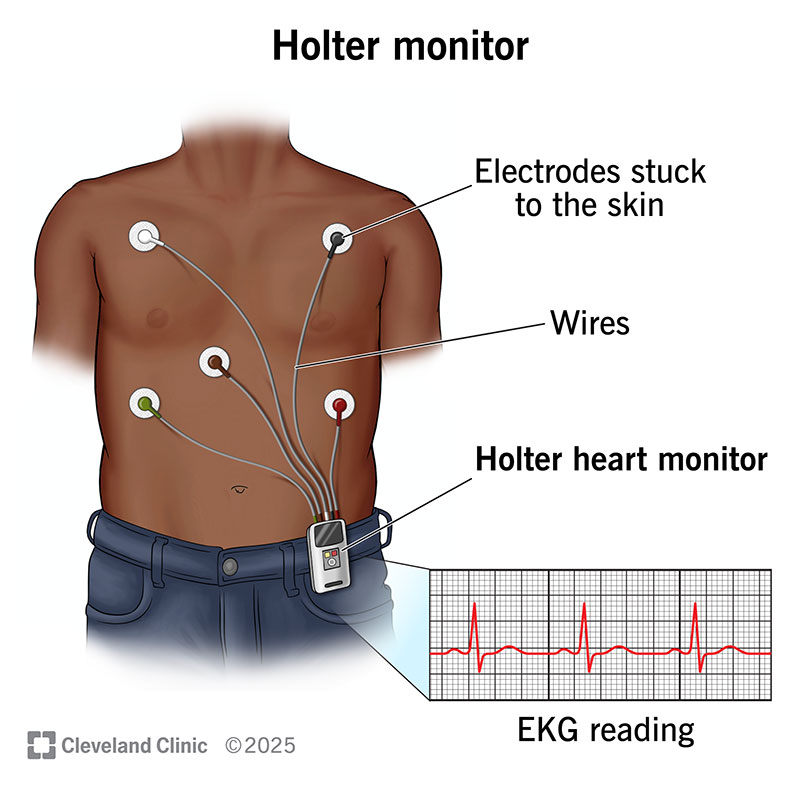A Holter monitor is a device you wear that records your heart’s electrical activity for 24 to 48 hours. You wear the Holter monitor while you do your daily activities. If you have an irregular heartbeat or heart palpitations but an EKG didn’t detect anything, a cardiac monitor can help diagnose the problem.
Advertisement
Cleveland Clinic is a non-profit academic medical center. Advertising on our site helps support our mission. We do not endorse non-Cleveland Clinic products or services. Policy

A Holter monitor is a wearable device and a type of ambulatory electrocardiogram. It’s a type of heart monitor. It records your heart’s rhythm and rate while you wear it for 24 to 48 hours without breaks. This gives your healthcare provider a long look at your heart’s electrical activity as you go about your day.
Advertisement
Cleveland Clinic is a non-profit academic medical center. Advertising on our site helps support our mission. We do not endorse non-Cleveland Clinic products or services. Policy
This monitor is small (about the size of a deck of playing cards), lightweight and runs on battery power. It has wires and electrodes (small patches) that stick to your skin. You wear a Holter monitor under your clothes while you continue with your regular daily activities.
A Holter monitor doesn’t give real-time information to your provider. If you’re concerned about your symptoms, seek emergency care.
The Holter monitor gets its name from Dr. Norman J. Holter, who created it in the 1950s.
Like an electrocardiogram (EKG), a Holter monitor gathers information about your heart’s electrical activity. Instead of wearing it for a few minutes like an EKG, you wear a Holter monitor for a full day or two. This allows for more chances to pick up unusual activity.
A Holter monitor can help if an EKG doesn’t provide clear results. It can:
A Holter monitor consists of the following:
Advertisement
Providers don’t check your device as it records information. They access the collected data after you turn it in.
You don’t need to do anything special to prepare for a Holter monitor. You’ll probably want to shower or bathe before putting on the device. You won’t be able to get the monitor wet when you’re wearing it.
A healthcare provider will get you set up, and then you can go about your normal day. They’ll:
While wearing your Holter monitor, you should avoid getting it wet. Don’t bathe, shower or swim. Water can damage the device.
You should also avoid things that can keep the sensors from communicating with the monitor, like:
After the 24- or 48-hour period, you return the monitor to your healthcare provider. They’ll remove the electrodes at this time. A provider processes your records, including the EKG and your notes. They send a report to your cardiologist (heart specialist).
Wearing a Holter monitor doesn’t involve any risks or pain. You might have itchiness or irritation from the tape that attaches the electrodes to your chest.
Let your provider know if you have any allergies to tapes or adhesives.
The results may show that the Holter monitor detected a heart rhythm disorder (arrhythmia), like:
Your provider will contact you with the results within a week or two after the test.
Your provider will discuss the next steps with you. They may recommend:
Advertisement
Contact your provider if:
Please note that a medical professional isn’t continuously monitoring the findings of this test. You should seek medical care if you develop symptoms.
A Holter monitor can’t diagnose anxiety. But if anxiety is causing you to have heart palpitations, the monitor will record them. Your provider will need to analyze the recording to see the kind of palpitations you had. It’s helpful to write down what you’re doing and feeling when you have symptoms.
An EKG measures your heart’s activity at that moment in time, as you’re having the test. But your heart’s rhythm and symptoms can change throughout the day.
Your provider may want to see how your heart’s rhythm changes during the day as you do your regular activities. The Holter monitor gives your provider a more complete picture of your heart rhythm.
Advertisement
A Holter monitor records your heart rhythm continuously for 24 or 48 hours. An event monitor isn’t continuous. It only records your heart’s activity when you feel symptoms and activate the monitor.
What’s causing your heart flutters, racing heart or dizziness? Not knowing the cause is frustrating. A Holter monitor may help you find out. While it may take a little getting used to, this small, painless device is something you only wear for a day or so. After that, you’re one step closer to a diagnosis and feeling better.
Advertisement
When your heart needs some help, the cardiology experts at Cleveland Clinic are here for you. We diagnose and treat the full spectrum of cardiovascular diseases.

Last reviewed on 04/14/2024.
Learn more about the Health Library and our editorial process.